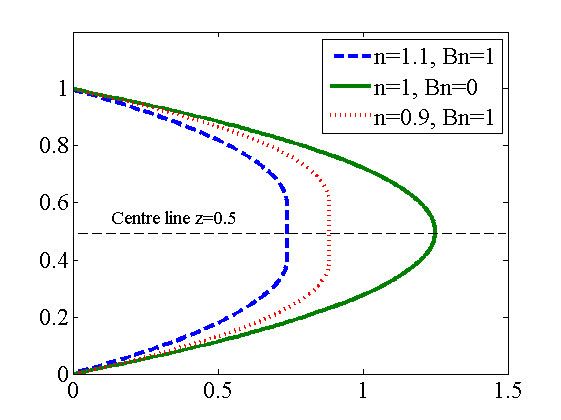 | ||
The Herschel–Bulkley fluid is a generalized model of a non-Newtonian fluid, in which the strain experienced by the fluid is related to the stress in a complicated, non-linear way. Three parameters characterize this relationship: the consistency k, the flow index n, and the yield shear stress
Contents
This non-Newtonian fluid model was introduced by Winslow Herschel and Ronald Bulkley in 1926.
Definition
The constitutive equation of the Herschel-Bulkley model is commonly written as
where
As a generalized Newtonian fluid model, the effective viscosity is given as
The limiting viscosity
The viscous stress tensor is given, in the usual way, as a viscosity, multiplied by the rate-of-strain tensor
where the magnitude of the shear rate is given by
The magnitude of the shear rate is an isotropic approximation, and it is coupled with the second invariant of the rate-of-strain tensor
Channel flow
A frequently-encountered situation in experiments is pressure-driven channel flow (see diagram). This situation exhibits an equilibrium in which there is flow only in the horizontal direction (along the pressure-gradient direction), and the pressure gradient and viscous effects are in balance. Then, the Navier-Stokes equations, together with the rheological model, reduce to a single equation:
To solve this equation it is necessary to non-dimensionalize the quantities involved. The channel depth H is chosen as a length scale, the mean velocity V is taken as a velocity scale, and the pressure scale is taken to be
which is negative for flow from left to right, and the Bingham number:
Next, the domain of the solution is broken up into three parts, valid for a negative pressure gradient:
Solving this equation gives the velocity profile:
Here k is a matching constant such that
Using the same continuity arguments, it is shown that
Since
Apply any pressure gradient smaller in magnitude than this critical value, and the fluid will not flow; its Bingham nature is thus apparent. Any pressure gradient greater in magnitude than this critical value will result in flow. The flow associated with a shear-thickening fluid is retarded relative to that associated with a shear-thinning fluid.
Pipe flow
For laminar flow Chilton and Stainsby provide the following equation to calculate the pressure drop. The equation requires an iterative solution to extract the pressure drop, as it is present on both sides of the equation.
allows standard Newtonian friction factor correlations to be used.
